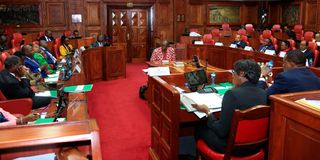How committee works during vetting and approval of Cabinet nominees

Outgoing Trade CS Betty Maina when she appeared before the Committee on Appointments on February 20, 2020.
Established in 2010 after the promulgation of the new constitution, the Committee on Appointments is tasked with vetting and approval of Cabinet secretary nominees.
It is a new concept that started towards the tail end of the reign of former President Mwai Kibaki. Previously, Cabinet secretaries were not vetted.
The committee is established under the provisions of Standing Order 204.
It’s membership include Speaker of the National Assembly as a chairperson, the Deputy Speaker, the Leader of the Majority Party, the Leader of the Minority party, the Deputy Leader of the Majority Party, the Deputy Leader of the Minority party and not more than 22 other members nominated by the House Business Committee, on the basis of proportional party membership in the House taking into consideration the numerical strength of the parties and interests of independent members
The committee is appointed within seven days of assembly of a new House and serves for a period of three years and that appointed thereafter shall serve for the remainder of the term of the Assembly
In the absence of the Speaker, the committee elects a member, from among its rank to chair the meeting.
The quorum of the Committee on Appointments is one half of the members, but the Speaker is not counted for the purposes of quorum and does not vote.
Upon the President nominating the Cabinet, he sends the names to Parliament where the Speaker of the National Assembly notifies members of the receipt of the communication from the President.
The National Assembly then forms a committee on appointments which is chaired by the Speaker to vet the nominees. The House can either reject in total or some nominees.
Parliament has until November 3 to vet the Cabinet secretary nominees after which, if approved by the House, then President Ruto will now formally appoint them into their various offices.
Initially, the committee had 14 days to vet the nominees but the 12th parliament amended the Parliamentary Approval Act, 2011 and increased the days to 28 arguing that two weeks is not enough to notify the public, conduct public participation, vet, retreat to write a report and give members time to debate and approve or reject the names.
During the vetting, the committee is expected to adhere to section 6(7) of the Parliamentary Approval Act which provides that the approval hearing should focus on a candidate’s academic credentials, professional training and experience, personal integrity and background.
Should any of the candidates be rejected by the committee and a decision upheld by the House, then the President has a right to nominate another candidate and submit the name to Parliament for approval.
If the 28 days stipulated for the conclusion of the process lapse before parliament makes a decision on a nominee, then the candidate will have been deemed to have been appointed.
After Parliament has concluded the vetting process, the Clerk of the National Assembly is expected to notify the President of the decision of the House within seven days.





